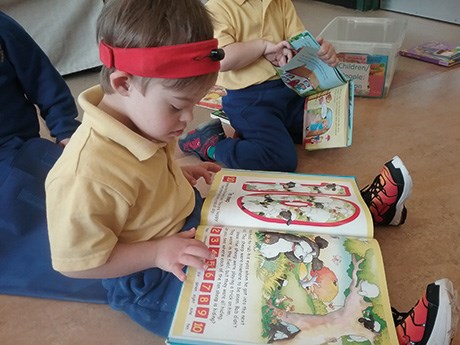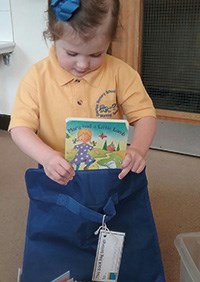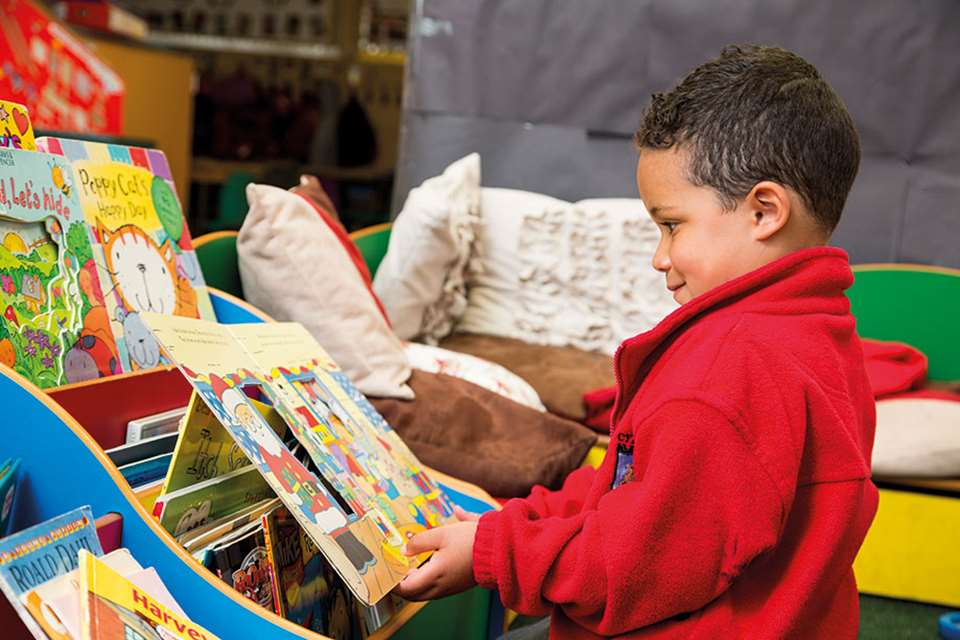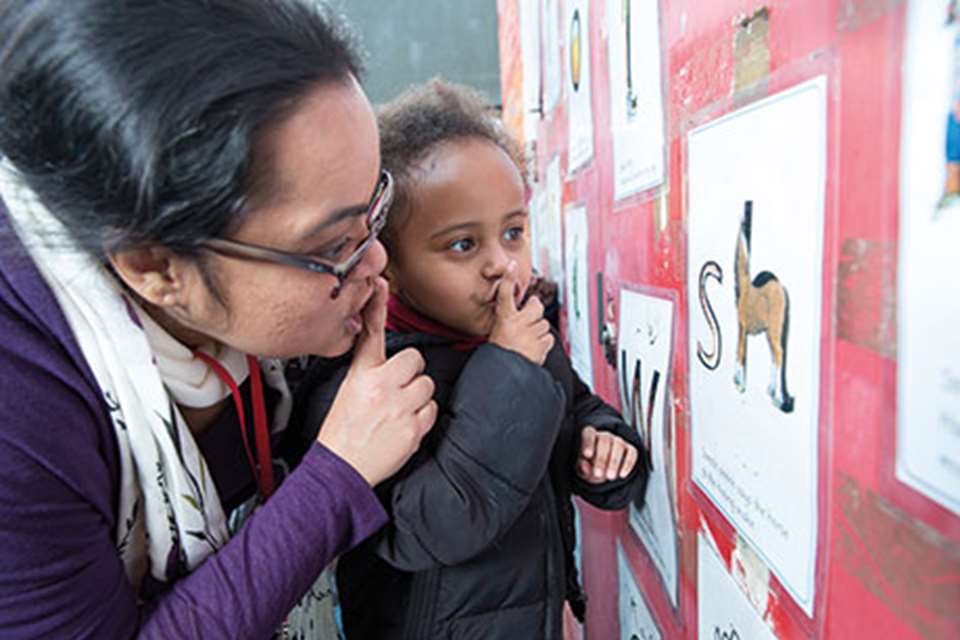Creating A Library - Shelf life
Amina Khan
Monday, May 13, 2019
How – and why – one setting created a library for two-year-olds and their parents. By Amina Khan, early childhood educator at Everton Nursery School and Family Centre in Liverpool

Download the PDF of this article
I’ve always loved books and was sad to see that the two-year-olds I work with tended not to be interested in looking at books and sharing stories. This inspired me to develop a library with the aim of enhancing the children’s engagement in exploring a range of books with their parents.
Everton Nursery School and Family Centre is situated in a deprived area of Liverpool and we can’t assume that all the children in our care have easy access to picture books at home.
While some children do talk of visiting the local library with their parents, there are others who have never been.
Children will frequently talk about sitting at home with the iPad or in front of the TV, rather than being exposed to books and, before introducing the library, some children would say that they didn’t have bedtime stories.
We noted that children’s verbal and social development were below the norm and we felt that encouraging sharing books at home would help to bring on their speech and communication skills and also help to build attachment and increased social skills.
I developed the library aimed at the two-year-olds in our care as part of the nursery school’s development plan. It has now been running for three years.
During that time I have evaluated how it works and made some simple changes in order for children and their parents to fully engage with it.
The aims of the library are:
- To develop an interest in books at a young age.
- To develop listening and attention skills.
- To develop children’s independence through having their own book bags.

WHAT TO CONSIDER
Developmentally appropriate I wanted to ensure that the books we offered would engage children and their parents. For this reason, I chose a range of books that had a lot of pictures and photographs, rather than being text-heavy. I included tactile books – with Usborne’s ‘That’s Not My…’ series proving very popular, those with pop-up features, buttons to press with sounds and hand puppet books which draw young children’s attention.
Variety I purposefully selected both fiction and non-fiction books covering a range of themes including traditional stories, such as ‘Goldilocks and the Three Bears’ and ‘The Three Little Pigs’. I also felt it was important to include rhyming texts and books with repetitive language to help to encourage the children’s speech and language development.
Durability Many of our children were not used to handling books and didn’t show much care towards them so we needed them to be durable. I included lots of large and small board books along with more traditional paper books. We do also have a small amount of funding in reserve so books that are lost or badly damaged can be replaced.
Appeal I took inviting front covers into consideration when choosing the books, along with those from known authors, books that are perennial favourites in the nursery and the cost.
Organisation I wanted to keep the library as simple as possible but felt that the books needed to be organised. Of course, two-year-olds wouldn’t understand a library classification system or recognise alphabetical order or author names and are only starting to become aware of the difference between fiction and non-fiction books. For these reasons, I chose to arrange the books into five simple categories:
- pop-up
- animals
- people and children
- numbers
- rhymes.
Resources Along with the books, I chose sturdy plastic boxes to store them in. We also bought book bags for the children in order to encourage them to take ownership of their borrowed books and take good care of them.
Opening times When to have the library open depends on staff or volunteer availability of who will organise the library. In the first year, I tried to be available at the end of the day twice a week for the children to exchange their books when their parents or carers came to collect them from nursery. I found that some parents were rushed because they had other children to pick up. Also, not all children attended on the days the library was open.
Now we continue to have specific library days so that parents are prompted to bring their children’s books back to change them, but I do change books on days outside the usual times if parents forget to bring the book back or their session is on a different day to the library. I want children and parents to stay engaged with it. Children can go in small groups during nursery time to choose books or select them with their parents at the end of the day.
Logistics We have a spacious corridor outside the two-year-old room so I put boxes of books there and choose some to lay out that I feel the children will be interested in, such as linking to role play or themes such as monsters or animals. I tend to limit it to three boxes so that the two-year-olds are not overwhelmed.
PARENTS AND CARERS
Engaging
I advertised the library and informed parents personally that I was developing it. Face-to-face contact and building a relationship with parents worked for me in encouraging parents to choose books with their children. I recommend books and talk about certain ones that are popular to encourage more borrowing. I also make a note of which books are borrowed most and suggest these to parents who haven’t visited the library before to build up their awareness of books and book choice with their two-year-old.
We have noted that parents and carers are keen for their child to borrow books from the library. They have sometimes asked for certain types of book, such as books with animals or with a theme such as going to the dentist. I also try to suggest specific books to children when I have observed they particularly enjoyed interacting with a book and listening to how it was shared during story sessions.
Supporting
Along with recommending a range of books to parents, we try to guide them informally in how to share the books with their two-year-olds.
Our advice includes:
Don’t feel obliged to always read the whole book with your child.
Talk about the pictures and what is happening in them.
Allow your child to get hands-on with the book, turning the pages, lifting any flaps, etc.
Find a cosy, quiet place to share the book together.
Link what you’ve read to your child’s own experiences – such as seeing animals in the park.
Try to use emphasis in your voice or use silly voices.
OUTCOMES
 Parents have become much more engaged in sharing books with their children and they will talk to us about bedtime stories and what they are reading with their child at home. Children continue to be excited to take books home in their book bags and to exchange them – although some children get attached to certain books and choose to take them home for a few weeks, which we support.
Parents have become much more engaged in sharing books with their children and they will talk to us about bedtime stories and what they are reading with their child at home. Children continue to be excited to take books home in their book bags and to exchange them – although some children get attached to certain books and choose to take them home for a few weeks, which we support.
We have always encouraged the children in our care to explore books, but now we have noticed that our two-year-olds are increasingly enthusiastic to share books with practitioners. They are also demonstrating care for books and we have many fewer damages.
Practitioners and parents have all commented that children are becoming more verbal and making more sounds.
I developed a book review and questionnaire with parents to monitor whether the choice of books matches the children’s needs and whether they found the library beneficial. One parent responded, ‘Yes, it is. It helps them start to recognise words and spend some one-to-one time.’
OUR POPULAR LIBRARY BOOKS
- Where’s Spot? by Eric Hill
- Whose Tail? by Sam Lloyd
- Buster’s Zoo by Rod Campbell
- The Things I Love About Play Time by Trace Moroney
- I Love My Daddy by Sebastien Braun
- Dear Zoo by Rod Campbell
- Princess Polly’s Potty by Andrea Pinnington
- The Runaway Tractor by Heather Amery and Stephen Cartwright
- Lula Loves Coloursby Camilla Reid and Ailie Busby
- One Mole Digging A Hole by Julia Donaldson and Nick Sharratt
- Ladybird Favourite Nursery Rhymes
- Ten in the Bed by Penny Dale
FURTHER INFORMATION
Everton Nursery School and Family Centre is the lead school for the North Liverpool Teaching School Partnership, www.evertonnurseryschoolandfamilycentre.org
Amina Khan spoke to Annette Rawstrone









